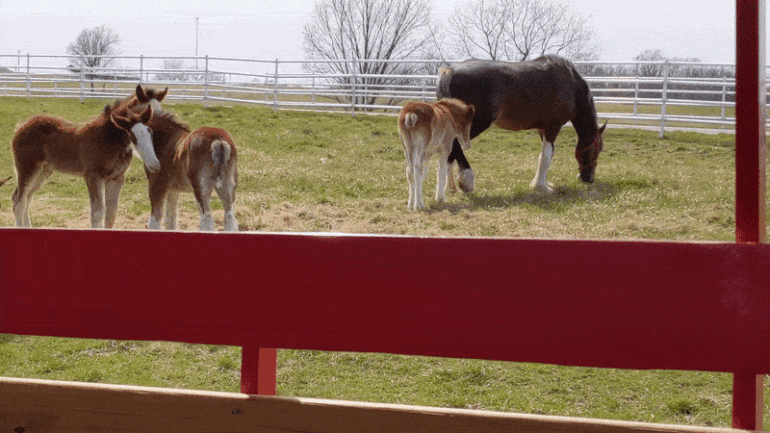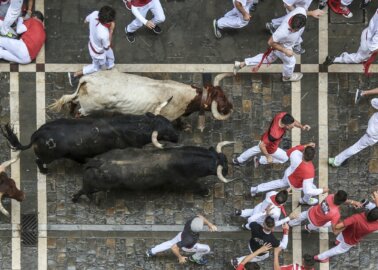Horses’ Tailbones Amputated for Budweiser Adverts and Parades
Update (20 September 2023):
After thousands of PETA supporters took action, Anheuser-Busch InBev announced that it has stopped amputating the tailbones of the Budweiser Clydesdales!
Original post (10 February 2023):
When the name “Budweiser” is mentioned, cold beer and summer barbecues may come to mind. What about the Budweiser Clydesdales?
The Budweiser Clydesdale are a group of horses exploited for promotions and adverts, often shown during the Super Bowl, by Anheuser-Busch Companies – Budweiser’s parent company.
A new PETA US investigation has gone behind the scenes of the famous Super Bowl adverts and revealed horse mutilation.
An Undercover Investigation
PETA US went undercover at Warm Springs Ranch in Missouri, US (the official breeding facility for the Budweiser Clydesdales); visited Grant’s Farm (where the horses are trained); and talked to handlers who travel with teams of the adult horses for events and parades. The group uncovered that horses’ tails are amputated so the famous Clydesdales will look a certain way as they pull the wagon.
Horses Need Their Tails
Clydesdales, like all horses, need their tails to protect themselves from biting insects – including those that carry West Nile virus and other pathogens. Their tails are also important for balance, mobility, and communication:
The tail supports and facilitates insect defense, comfort, welfare, reproduction, and disease prevention. It is abusive and inhumane to deprive a horse of her tail. Tail amputation results in a lifetime of impaired balance moving at speed running and turning. It is animal-abusive and medically undignified to deprive a horse of their tail, except in cases of medical necessity.
– Sid Gustafson, equine veterinarian
Amputating a horse’s tail (commonly called “tail docking”) is so cruel that this needless cosmetic procedure is illegal in the UK, unless performed by a veterinarian for medical reasons.
Amputated With Scalpels or Bands to Stop Blood Flow
Tail amputation involves what one equine veterinarian calls “surgical abuse”. When the Budweiser Clydesdales are still foals, the bones of their tails, which are part of their spines, are completely or partially amputated, either with a scalpel or by putting a band around the tail to stop the blood flow until the tail drops off.


According to veterinary experts, both procedures are very painful and the band method is especially excruciating. The suffering caused by tail amputation can persist for the horse’s entire life, as pointed out in a 2018 article published in Scientific American:
Many people who raise draft horses partake in the brutal practice of tail-docking, in which a horse’s tailbones are severed, mostly for aesthetic reasons. Our work shows that a horse’s tail isn’t just an ornament. It’s their main line of defense against biting insects.
Look at these Clydesdales in constant distress, unable to protect themselves from insects:
Misleading Statements
Some of Budweiser’s representatives mislead the public about what’s done to these horses. Staff at Warm Springs Ranch claim they simply “pull” the tails – which means thinning the tail by wrapping hairs around a comb and pulling them out – in order to keep them clean during breeding and birthing. At a parade in Annapolis, Maryland, US, where the horses were making an appearance, one Clydesdale handler denied that the horses’ tailbones are amputated.
Budweiser handler 1: “If they’re long they can grab the line … it’s a safety thing.”
Investigator: “Do they dock the tail?”
Budweiser handler 1: “No, we just trim them weekly. They still have their tails, it’s just we trim the hair.”
Investigator: “Oh, so they’re, like, the full tails still, they’re just tied up?”
Budweiser handler 1: “Yup.”


But other representatives, including a tour guide at Grant’s Farm, revealed the truth:
Yeah, they are cut early on. I know that. And that’s for hygiene reasons. It’s also when they get prepared here, they make that into a bun and put that bow on it. And it’s just so they don’t get tangled up in the reins and things, so they do cut the tail, ’cause they would go all the way to the ground.
A different Clydesdale handler at the Annapolis parade also told a PETA US investigator that the horses’ tailbones are removed:
Investigator: “They are docked?”
Budweiser handler 2: “Yup … I’m not exactly sure when Budweiser does it, but typically when they’re pretty young.”
‘Safety’ Excuses Are Full of Hot Air
The alleged “safety” reasons for this abuse don’t hold up. Braiding the hair of the horses’ tails and then wrapping the tail in bandaging material, as is frequently done when horses are transported, would prevent it from getting caught in the wagon-hitch equipment:
The practice originated from human laziness. It was easier for animal-inconsiderate draft horse people to cut the tail of their draft babies, inflicting a lifetime impairment of normal behavior, rather than taking the time to braid or tie up the tails and utilize the correct harnessing tack, as is the custom of animal-sensitive folks. Any and all perceived problems by humans regarding the tails of driving horses can be adequately, humanely, and effectively managed. There are no safety issues with horses having their tails fully intact.
– Sid Gustafson, equine veterinarian
Join the Campaign
PETA US contacted Anheuser-Busch and urged the company to stop using horses with amputated tailbones immediately. But no one has bothered to respond.
So just in time for the Super Bowl, PETA US launched its own Clydesdale ad …
… and billboards:
Budweiser must stop using mutilated horses immediately. Please send the company a message now:




